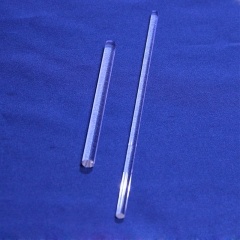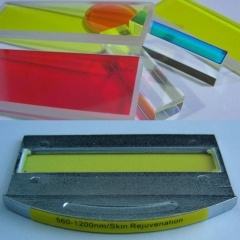Made from BK7 material, which has transparent range from 330-2100nm. The refractive index is 1.5168 at 587.6nm. The BK7 window has good performance over visible and near IR spectrum for most application.
Achromatic Waveplate Achromatic Waveplates(Retarders), AWP is composed of one piece of Crystal Quartz and one piece of Magnesium Fluoride, MgF2.
Barium fluoride (BaF2) shows good optical transmission over UV-IR windows in 0.15μm~12.5μm.
MgF2 windows are used in the UV, visible and IR ranges, with approximately 94% transmission from 200 - 1000 nm, and approximately 95% transmission from 1-6µm
CaF2 has transparent range from 170-7800nm. The refractive index is 1.399 at 5000nm. 1. Low absorption coefficient 2. High damage threshold, 3. Low Dispersion (with an Abbe Number of 95) 4. Low fluorescence 5. Excellent water, chemical, and heat resistance
Hot and Cold Mirror is applications IR-Filters for CCD-Chips Projectors Lighting Systems Detector Trimmers Sensors.
Hot Mirrors Reflect IR
Cold Mirrors Reflect Visible Light
0° and 45° AOI Available
product orgin:
Chinashipping port:
Fuzhou Chinapayment:
T/T Payment, Western UnionHot and Cold Mirrors
Hot and Cold Mirrors is applications IR-Filters for CCD-Chips Projectors Lighting Systems Detector Trimmers Sensors.
Hot Mirrors Reflect IR
Cold Mirrors Reflect Visible Light
0° and 45° AOI Available
Hot mirrors transmit visible light and reflect IR, allowing them to protect heat-sensitive elements by reflecting IR energy. In contrast, cold mirrors reflect visible light and transmit IR. They are ideal for projection applications and for use as low- and high-pass filters.
Specification
Material:
Borofloat, Fused Silica, Soda-Lime Glass
Dimension Tolerance:
+0.0, -0.1mm
Thickness Tolerance:
±0.2mm
Surface quality:
80/50
Clear Aperture:
>85%
Flatness:
5 λ per 25mm@633nm
Parallelism:
<3'
Bevel:
<0.25mm X 45°
Coating:
Reflectance:
Cold Mirror:R>85% @700-1100nm
Hot Mirror: R<5%@ 700-1100nm
Transmittance :
Cold Mirror: T<5%@ 400-700nm
Hot Mirror: T>75%@ 400-700nm


Different Shape, Size, Material and Coating are available.
 LiNbO3 and MgO-LiNbO3 Nonlinear Crystal
LiNbO3 and MgO-LiNbO3 Nonlinear Crystal
LiNbO3 crystal is widely used as frequency doublers for wavelength > 1mm and optical parametric oscillators (OPOs) pumped at 1064 nm.
 High Presion Double Convex Lenses and Bi-convex Lenses
High Presion Double Convex Lenses and Bi-convex Lenses
Double Convex Lenses, Bi-convex Lenses have two outward curved surfaces, a positive focal length and are useful for 1:1 imaging and in multi-element systems.These lenses are designed to have a focal length of f= (R1*R2)/((n-1)*(R2-R1)) 1. Supported by the Zemax Optical Design Package 2. Posistive Focal Length 3. Material upon requirement
 Rods Lenses and Light pipes
Rods Lenses and Light pipes
Rod lenses Light pipes is used in the fields of medical, electronic, information, agriculture, communication and etc. 1.All surfaces (end-faces and cylinder)polished; 2.Only end-faces polished; 3.Only Cylinder polished.
 IPL Filters for Intense Pulsed Light Machine
IPL Filters for Intense Pulsed Light Machine
IPL filter is the key optical element for IPL (intense Pulsed Light) machine, Their main application: 1. Photrevujenation 2. Hair removal 3. Vascular 4. Acne treatment.
 N-BK7 and Fused Silica Wedge Prisms and Wedge Windows
N-BK7 and Fused Silica Wedge Prisms and Wedge Windows
Wedge Prisms (Wedge Windows) are ideal for laser beam steering applications. Also known as Risley prisms, these optics deflect a beam normal to the prism's perpendicular surface through an angular deviation.
 Optical Glass Ball Lenses and Half ball lenses
Optical Glass Ball Lenses and Half ball lenses
Optical glass ball lenses are commonly used 1. Laser collimating and focusing 2. Laser-to-fiber coupling 3. Fiber-to-fiber coupling 4. Fiber-to-detector coupling
friendly links :
copyright © 2024 WTS PHOTONICS CO., LTD.all rights reserved. powered by dyyseo.com .
wts photonics